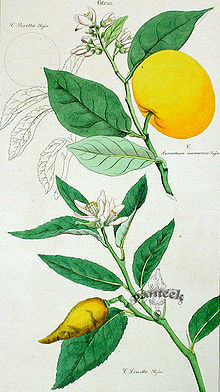| Citrus limetta | |
|---|---|

| |
| Scientific classification | |
| Kingdom: | Plantae |
| Clade: | Tracheophytes |
| Clade: | Angiosperms |
| Clade: | Eudicots |
| Clade: | Rosids |
| Order: | Sapindales |
| Family: | Rutaceae |
| Genus: | Citrus |
| Species: | C. limetta
|
| Binomial name | |
| Citrus limetta | |
Citrus limetta, alternatively considered to be a cultivar of Citrus limon, C. limon 'Limetta',[1] is a species of citrus, commonly known as mousami, musami, mosambi, sweet lime, sweet lemon, and sweet limetta, it is a member of the sweet lemons. It is small and round like a common lime in shape.[2] It is a cross between the citron (Citrus medica) and a bitter orange (Citrus × aurantium).[3]
It is native to southern regions of Iran[4] and also cultivated in the Mediterranean Basin. It is a different fruit from the Palestinian sweet lime[5] and from familiar sour limes such as the Key lime and the Persian lime. However, genomic analysis revealed it to be highly similar to the Rhobs el Arsa, and the two likely represent progeny of distinct crosses of the same citrus parents.[3]
The South Asian cultivars originated in Mozambique and were brought to South Asia by the Portuguese. The common name musambi and its variants trace their origin to Mozambique.[6][7]
- ^ Porcher, Michel H.; et al. (1995). "Sorting Citrus Names". Multilingual Multiscript Plant Name Database (M.M.P.N.D). The University of Melbourne.
- ^ "Citrus Limetta Shape of Fruit". Archived from the original on 2023-02-02. Retrieved 2021-01-30.
- ^ a b Curk, Franck; Ollitrault, Frédérique; Garcia-Lor, Andres; Luro, François; Navarro, Luis; Ollitrault, Patrick (2016). "Phylogenetic origin of limes and lemons revealed by cytoplasmic and nuclear markers". Annals of Botany. 11 (4): 565–583. doi:10.1093/aob/mcw005. PMC 4817432. PMID 26944784.
- ^ http://www.specialtyproduce.com/produce/Persian_Sweet_Lemons_10194.php, "Persian Sweet lemons are believed to be native to southern regions of Iran".
- ^ Palestine Archived 2019-07-26 at the Wayback Machine at Citrus Variety Collection Website, Volume I Archived 2012-02-05 at the Wayback Machine See heading: Indian (Palestine)
- ^ Masica, Colin P. (1979), Deshpande, Madhav M.; Hook, Peter Edwin (eds.), "Aryan and Non-Aryan Elements in North Indian Agriculture", Aryan and Non-Aryan in India, University of Michigan Press, p. 91, doi:10.3998/mpub.19419, ISBN 978-0-89148-045-7, JSTOR 10.3998/mpub.19419, retrieved 2023-11-06
- ^ Cheema, G. S.; Bhat, S. S. (1934). "A Study of the Citrus Varieties of the Bombay Presidency". Current Science. 2 (8): 298–304. ISSN 0011-3891. JSTOR 24203386.